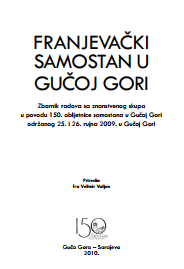Katolici i franjevci u srednjovjekovnoj župi (županiji) Lašva
Catholics and Franciscans in the medieval parish (county) of Lašva
Author(s): Milko Brkovic
Subject(s): Christian Theology and Religion, Middle Ages, Other Christian Denominations, Sociology of Religion
Published by: Franjevačka teologija Sarajevo
Keywords: Bosnia; Bosnian Banate; Catholic; Franciscans; medieval age; Lašva; parish;
Summary/Abstract: The middle-age parish and district Lašva were spread out on both sides and on the full length from the source to the mouth of the homonymous river Lašva; probably the name of the residence originates from that fact. From the 12th century and up to conquest of the Ottomans in 1463, the district Lašva was incorporated in the Bosnian State like one of the seven middle age districts composing the original Banate of Bosnia. The Bosnian Catholics were a component of the Bosnian middle-age Christians. The parishes in middle ages belonged to the Bosnian Catholic Diocese, which had existed before the question on the orthodoxy of Bosnian Christians was asked. The term Bosnian Church according to the sources is the same as the Bosnian Diocese. The Bosnian Church from the beginning belonged to the West, in other words to the Roman Church, and its bishop was the teacher of the local community as he was the bishop of Rome. When the Bosnian Christians and their bishop became suspected of heresy, in the same way the Church of Dubrovnik with its archbishop was also groundlessly suspected because allegedly he didn’t take enough care of the people when he appointed for the Bosnian bishop. There is the argument that the Bosnian Church never broke its community and connections with the Roman Church, although it was accused of being heretical. But the Bosnian Church had to suffer, to experience rejection, and even once be without its head bishop and without connection to its archdiocese community. Beginning in the 13th century, the Pope’s authoritative representatives demonstrated the orthodoxy of local Christians, but conflicts arse when the Hungarian Church and civilian authorities took e over the role of Rome. The real problems were with the liturgical language, different taxes and political aspirations of the Hungarian and Venetian authorities. The consequence was first the exclusion of the Bosnian Diocese from the jurisdiction of Dioceses Split, Bar and Dubrovnik, and subsequently replacing the residence of the Bosnian Metropolis. On one side was the weakened Bosnian Diocese and Bosnian vassal rulers, and on the other. the strong Hungarian Church and government which, after establishing of Zagreb Diocese, removing the Croatian bishop and installing a group of Hungarian people at the Archdiocese curia in Split, dividing and absorbing the Bosnian Diocese, it replaced its residence and subjugated it to the head of Hungarian Church. The Bosnian Church community kept acting outside of the official Catholic Church, which automatically subjected it to be considered disobedient to the discipline of the Catholic Church, but not to heterodoxy. The faith of the Bosnian Church is the Catholic one. There is no contemporary treatise disputing a Credo or structure of Bosnian Christians, but there are other different contemporary sources testifying almost all the truths of the Apostolic Credo. According to foreign sources, the Bosnian Christian community fell to heterodoxy, but according to the documents of Bosnian rulers and nobility, there was no heterodoxy. The middle age Scriptures of Bosnian Christians, as the Old Testament, and also the New One, have no difference in regular orthodox Biblical codex from West or East tradition. An excellent example of middle age Bosnian New Testament codex is Zbornik krstjanina Hvala from 1404 year. One bishop during the Church Council in Basel witnessed on Bosnian Christians: “When they saw me dressed in bishop suit, I could not lift my legs because of their kissing.” The Bosnian middle age Franciscans were correct Catholics and true representatives of Catholicism in Bosnia, and thus in Lašva. The well-known indiscipline and licentiousness of higher clergy in the Catholic Church in 12th and 13th century were contrasted to the simple and sincere believers in Bosnia. In historical sources there is no evidence that Franciscans tortured alleged Bosnian heretics. The official Franciscan mission in Bosnian Banate, and thus in Lašva parish, started during pope Nikola IV (1288-1292).
Book: Franjevački samostan u Gučoj Gori
- Page Range: 41-112
- Page Count: 72
- Publication Year: 2010
- Language: Croatian
- Content File-PDF

